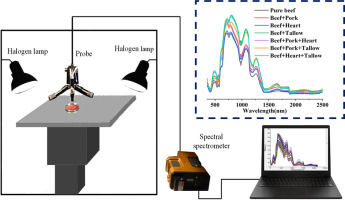当前位置:
X-MOL 学术
›
Spectrochim. Acta. A Mol. Biomol. Spectrosc.
›
论文详情
Our official English website, www.x-mol.net, welcomes your
feedback! (Note: you will need to create a separate account there.)
Rapid detection of adulteration of minced beef using Vis/NIR reflectance spectroscopy with multivariate methods.
Spectrochimica Acta Part A: Molecular and Biomolecular Spectroscopy ( IF 4.3 ) Pub Date : 2020-01-14 , DOI: 10.1016/j.saa.2019.118005 Shizhuang Weng 1 , Bingqing Guo 1 , Peipei Tang 1 , Xun Yin 1 , Fangfang Pan 1 , Jinling Zhao 1 , Linsheng Huang 1 , Dongyan Zhang 1
Spectrochimica Acta Part A: Molecular and Biomolecular Spectroscopy ( IF 4.3 ) Pub Date : 2020-01-14 , DOI: 10.1016/j.saa.2019.118005 Shizhuang Weng 1 , Bingqing Guo 1 , Peipei Tang 1 , Xun Yin 1 , Fangfang Pan 1 , Jinling Zhao 1 , Linsheng Huang 1 , Dongyan Zhang 1
Affiliation

|
High economic returns induce the continuous occurrence of meat adulteration. In this study, visible/near-infrared (Vis/NIR) reflectance spectroscopy with multivariate methods was used for the rapid detection of adulteration in minced beef. First, the reflectance spectra of different adulterated minced beef samples were measured at 350-2500 nm. Standardization and Savitzky-Golay (SG) smoothing were applied to reduce spectral interference and noise. Then, support vector machine (SVM), random forest (RF), partial least squares regression (PLSR), and deep convolutional neural network (DCNN) were adopted for adulteration type identification and level prediction. Moreover, principal component analysis (PCA), locally linear embedding (LLE), subwindow permutation analysis (SPA), and competitive adaptive reweighted sampling (CARS) were performed to eliminate redundant information. SG smoothing performed better on interference reduction. DCNN and PCA identified adulteration type with the accuracy above 99%. In adulteration level prediction, the RF with spectra of important wavelengths selected by CARS provided optimal performance for beef adulterated with pork, and coefficient of determination of prediction (R2P) and the root mean square error of prediction (RMSEP) were 0.973 and 2.145. The best prediction for beef adulterated with beef heart was obtained using PLSR and CARS with R2P of 0.960 and RMSEP of 2.758. Accordingly, Vis/NIR reflectance spectroscopy coupled with multivariate methods can provide the rapid and accurate detection of adulterated minced beef.
中文翻译:

使用多元方法的Vis / NIR反射光谱法快速检测碎牛肉的掺假情况。
高经济效益促使肉类掺假现象不断发生。在这项研究中,使用可见/近红外(Vis / NIR)反射光谱与多变量方法来快速检测碎牛肉中的掺假。首先,在350-2500 nm处测量了不同掺假的碎牛肉样品的反射光谱。应用标准化和Savitzky-Golay(SG)平滑以减少频谱干扰和噪声。然后,采用支持向量机(SVM),随机森林(RF),偏最小二乘回归(PLSR)和深度卷积神经网络(DCNN)进行掺假类型识别和水平预测。此外,主成分分析(PCA),局部线性嵌入(LLE),子窗口置换分析(SPA),并进行竞争性自适应加权加权抽样(CARS)以消除冗余信息。SG平滑在减少干扰方面表现更好。DCNN和PCA识别出掺假类型,其准确率超过99%。在掺假水平预测中,具有CARS选择的重要波长光谱的RF为掺假猪肉提供了最佳性能,预测确定系数(R2P)和预测均方根误差(RMSEP)为0.973和2.145。使用PLSR和CARS(R2P为0.960,RMSEP为2.758)获得对掺有牛心的牛肉的最佳预测。因此,Vis / NIR反射光谱技术与多变量方法相结合可以快速而准确地检测出掺假的碎牛肉。SG平滑在减少干扰方面表现更好。DCNN和PCA识别出掺假类型,其准确率超过99%。在掺假水平预测中,具有CARS选择的重要波长光谱的RF为掺假猪肉提供了最佳性能,预测确定系数(R2P)和预测均方根误差(RMSEP)为0.973和2.145。使用PLSR和CARS(R2P为0.960,RMSEP为2.758)获得对掺有牛心的牛肉的最佳预测。因此,Vis / NIR反射光谱技术与多变量方法相结合可以快速而准确地检测出掺假的碎牛肉。SG平滑在减少干扰方面表现更好。DCNN和PCA识别出掺假类型,其准确率超过99%。在掺假水平预测中,具有CARS选择的重要波长光谱的RF为掺假猪肉提供了最佳性能,预测确定系数(R2P)和预测均方根误差(RMSEP)为0.973和2.145。使用PLSR和CARS(R2P为0.960,RMSEP为2.758)获得对掺有牛心的牛肉的最佳预测。因此,Vis / NIR反射光谱技术与多变量方法相结合可以快速而准确地检测出掺假的碎牛肉。CARS选择的具有重要波长光谱的RF为猪肉掺假牛肉提供了最佳性能,预测的确定系数(R2P)和预测的均方根误差(RMSEP)为0.973和2.145。使用PLSR和CARS(R2P为0.960,RMSEP为2.758)获得对掺有牛心的牛肉的最佳预测。因此,Vis / NIR反射光谱技术与多变量方法相结合可以快速而准确地检测出掺假的碎牛肉。CARS选择的具有重要波长光谱的RF为掺假猪肉提供了最佳性能,预测的确定系数(R2P)和预测的均方根误差(RMSEP)为0.973和2.145。使用PLSR和CARS(R2P为0.960,RMSEP为2.758)获得对掺有牛心的牛肉的最佳预测。因此,Vis / NIR反射光谱技术与多变量方法相结合可以快速而准确地检测出掺假的碎牛肉。960,RMSEP为2.758。因此,Vis / NIR反射光谱技术与多变量方法相结合可以快速而准确地检测出掺假的碎牛肉。960,RMSEP为2.758。因此,Vis / NIR反射光谱技术与多变量方法相结合可以快速而准确地检测出掺假的碎牛肉。
更新日期:2020-01-15
中文翻译:

使用多元方法的Vis / NIR反射光谱法快速检测碎牛肉的掺假情况。
高经济效益促使肉类掺假现象不断发生。在这项研究中,使用可见/近红外(Vis / NIR)反射光谱与多变量方法来快速检测碎牛肉中的掺假。首先,在350-2500 nm处测量了不同掺假的碎牛肉样品的反射光谱。应用标准化和Savitzky-Golay(SG)平滑以减少频谱干扰和噪声。然后,采用支持向量机(SVM),随机森林(RF),偏最小二乘回归(PLSR)和深度卷积神经网络(DCNN)进行掺假类型识别和水平预测。此外,主成分分析(PCA),局部线性嵌入(LLE),子窗口置换分析(SPA),并进行竞争性自适应加权加权抽样(CARS)以消除冗余信息。SG平滑在减少干扰方面表现更好。DCNN和PCA识别出掺假类型,其准确率超过99%。在掺假水平预测中,具有CARS选择的重要波长光谱的RF为掺假猪肉提供了最佳性能,预测确定系数(R2P)和预测均方根误差(RMSEP)为0.973和2.145。使用PLSR和CARS(R2P为0.960,RMSEP为2.758)获得对掺有牛心的牛肉的最佳预测。因此,Vis / NIR反射光谱技术与多变量方法相结合可以快速而准确地检测出掺假的碎牛肉。SG平滑在减少干扰方面表现更好。DCNN和PCA识别出掺假类型,其准确率超过99%。在掺假水平预测中,具有CARS选择的重要波长光谱的RF为掺假猪肉提供了最佳性能,预测确定系数(R2P)和预测均方根误差(RMSEP)为0.973和2.145。使用PLSR和CARS(R2P为0.960,RMSEP为2.758)获得对掺有牛心的牛肉的最佳预测。因此,Vis / NIR反射光谱技术与多变量方法相结合可以快速而准确地检测出掺假的碎牛肉。SG平滑在减少干扰方面表现更好。DCNN和PCA识别出掺假类型,其准确率超过99%。在掺假水平预测中,具有CARS选择的重要波长光谱的RF为掺假猪肉提供了最佳性能,预测确定系数(R2P)和预测均方根误差(RMSEP)为0.973和2.145。使用PLSR和CARS(R2P为0.960,RMSEP为2.758)获得对掺有牛心的牛肉的最佳预测。因此,Vis / NIR反射光谱技术与多变量方法相结合可以快速而准确地检测出掺假的碎牛肉。CARS选择的具有重要波长光谱的RF为猪肉掺假牛肉提供了最佳性能,预测的确定系数(R2P)和预测的均方根误差(RMSEP)为0.973和2.145。使用PLSR和CARS(R2P为0.960,RMSEP为2.758)获得对掺有牛心的牛肉的最佳预测。因此,Vis / NIR反射光谱技术与多变量方法相结合可以快速而准确地检测出掺假的碎牛肉。CARS选择的具有重要波长光谱的RF为掺假猪肉提供了最佳性能,预测的确定系数(R2P)和预测的均方根误差(RMSEP)为0.973和2.145。使用PLSR和CARS(R2P为0.960,RMSEP为2.758)获得对掺有牛心的牛肉的最佳预测。因此,Vis / NIR反射光谱技术与多变量方法相结合可以快速而准确地检测出掺假的碎牛肉。960,RMSEP为2.758。因此,Vis / NIR反射光谱技术与多变量方法相结合可以快速而准确地检测出掺假的碎牛肉。960,RMSEP为2.758。因此,Vis / NIR反射光谱技术与多变量方法相结合可以快速而准确地检测出掺假的碎牛肉。











































 京公网安备 11010802027423号
京公网安备 11010802027423号